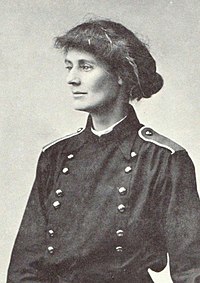Constance Markievicz
| Constance Georgine Markievicz | |
|---|---|

Constance Markievicz
|
|
| Member of Parliament | |
|
In office 1918–1922 |
|
| Constituency | Dublin St Patrick's |
| Teachta Dála | |
|
In office December 1918 – May 1921 |
|
| Constituency | Dublin St Patrick's |
|
In office May 1921 – June 1922 |
|
|
In office August 1923 – July 1927 |
|
| Constituency | Dublin South |
| Minister for Labour | |
|
In office April 1919 – January 1922 |
|
| Preceded by | New office |
| Succeeded by | Joseph McGrath |
| Personal details | |
| Born |
Constance Georgine Gore-Booth 4 February 1868 Buckingham Gate, London, England |
| Died | 15 July 1927 (aged 59) Sir Patrick Dun's Hospital, Dublin, Ireland |
| Resting place |
Glasnevin Cemetery, Dublin, Ireland |
| Political party |
Sinn Féin, Fianna Fáil |
| Spouse(s) | Casimir Markievicz (m. 1900) |
| Children | Maeve Markievicz (1901–62) |
| Religion |
Church of Ireland, later Roman Catholic |
| Military service | |
| Allegiance |
Irish Republican Brotherhood Irish Citizen Army Irish Republican Army Cumann na mBan |
| Years of service | 1913–23 |
| Rank |
Third-in-command Lieutenant |
| Battles/wars |
Dublin Lockout Easter Rising Irish War of Independence Irish Civil War |
Constance Georgine Markievicz, known as Countess Markievicz (Polish: Markiewicz [markˈjɛvit͡ʂ]; née Gore-Booth; 4 February 1868 – 15 July 1927) was an Irish Sinn Féin and Fianna Fáil politician, revolutionary nationalist, suffragette and socialist. In December 1918, she was the first woman elected to the British House of Commons, though she did not take her seat and, along with the other Sinn Féin TDs, formed the first Dáil Éireann. She was also the second woman to hold a cabinet position in the world (Minister for Labour of the Irish Republic, 1919–1922).
Markievicz was born Constance Georgine Gore-Booth at Buckingham Gate in London, the elder daughter of the Arctic explorer and adventurer Sir Henry Gore-Booth, 5th Baronet, an Anglo-Irish landlord who administered a 100 km2 (39 sq mi) estate, and Georgina, Lady Gore-Booth née Hill. During the famine of 1879–80, Sir Henry provided free food for the tenants on his estate at Lissadell House in the north of County Sligo in the north-west of Ireland. Their father's example inspired in Gore-Booth and her younger sister, Eva Gore-Booth, a deep concern for working people and the poor. The sisters were childhood friends of the poet W. B. Yeats, who frequently visited the family home Lissadell House, and were influenced by his artistic and political ideas. Yeats wrote a poem, "In Memory of Eva Gore-Booth and Con Markiewicz", in which he described the sisters as "two girls in silk kimonos, both beautiful, one a gazelle" (the gazelle being Constance). Eva later became involved in the labour movement and women's suffrage in England, although initially Constance did not share her sister's ideals.
...
Wikipedia
